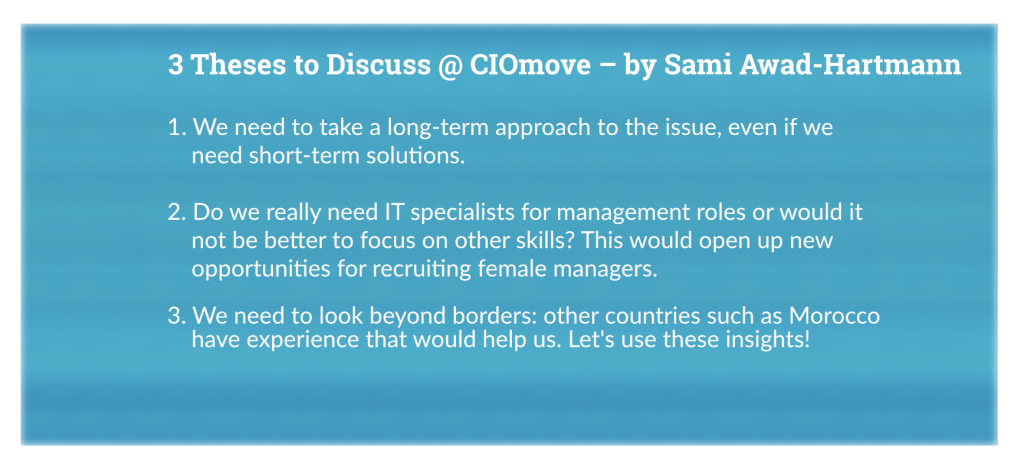
“More women in IT” is what Sami Awad-Hartmann from Hellmann wants. Is there anyone who is against this? Hardly, and yet women are clearly underrepresented in IT, and women in IT management positions even more so.

The “Digital Leadership Report” by Nash Squared comes to the conclusion for 2022 that only 12% of management positions in the tech sector worldwide are held by women. And VOICE, the largest IT user association in Germany, has discovered through its own research that not even seven per cent of all IT management positions such as CIO and CDO are held by women.
Analyses by leading consulting firms show that doubling the proportion of women in tech jobs to 45 per cent by 2027 could increase Europe’s gross domestic product by 600 billion euros.
Women bring valuable skills and potential that have not yet been utilised. Their different perspectives and experiences contribute to innovation. If more women work in IT, there will be more diverse ideas and solutions.
Sami quite rightly asks how we can change this and wants to make it a topic of discussion at CIOmove. How can we increase the proportion of women in IT? What can we do in the short term and what are long-term measures? And anyway: Is this more of a German problem and if so, what can we learn from other countries?
More women in IT – there’s a long way to go
It will be a long road to get more women into IT. We need to start working on this in schools and universities. Let’s hear from IT consultant and full-stack developer Anna Maier, who said in an interview with the “Women in Tech” network: “There are now many great initiatives that are trying to get girls interested in technology. But in order to reach everyone, there needs to be a much stronger focus on this in school education itself.”
This work is important and ultimately indispensable, but it will not solve the current problem until – and hopefully – in a few years’ time, with more female pupils and science subjects and more female students of computer science and related disciplines.
Anna Maier also addresses another important aspect: “At the same time, the women who work in this field are often not visible,” she says and explains what this means for her career: “There were situations where I was ignored and discriminated against as a woman. That’s why she and many others like her argue that women in IT need more visibility: “We could achieve a lot with more female role models.”
Marlene Damerau, Smart City Unit Leader of the city of Gelsenkirchen, also summarised the impact of such role models at Women in Tech: “Understand what you bring to the table as an advantage: the female perspective – be it the user perspective, the citizen perspective or the perspective on the needs of children – is very, very important.” And a little later: “Be aware of the added value you can offer an organisation. This can be, above all, a different way of thinking or perceiving things.”
Measures for more visibility
In addition to more visibility, but basically also to create this visibility in the first place, there are various options that companies can tackle directly and without major preparations or transformations:
- Show the variety and diversity of your teams, for example on social media. This will create role models that appeal to target groups other than nerdy men.
- When recruiting, specifically target women and use agencies that specialise in recruiting female employees. They have the networks and resources to search specifically for women.
- However, this alone does not solve the problem: the shortage of skilled labour, particularly in IT, does not give us the freedom to specifically look for female employees. We are happy about all qualified employees who apply.
- Flexible and family-friendly working models (home office, part-time work, remote work or job sharing) are offers for all employees, but especially for female employees, who can be brought into working life, kept there and – just as importantly – reintegrated after a maternity leave.
- Mentoring programmes can be used to open up career paths for female employees in particular and to support them in pursuing these paths.
(Source: https://www.computerwoche.de/a/7-massnahmen-fuer-mehr-frauen-in-der-it,3613113)
These are some, but certainly not all, of the ways to increase the proportion of female IT staff and, above all, female IT managers. What experiences have you had? How do you promote the proportion of female IT managers? We are looking forward to the discussion at CIOmove 2024 in Morocco, a country where more women than men study IT professions and which is already much further ahead than many (European) countries, especially when it comes to recruiting female IT specialists. This will be exciting!
